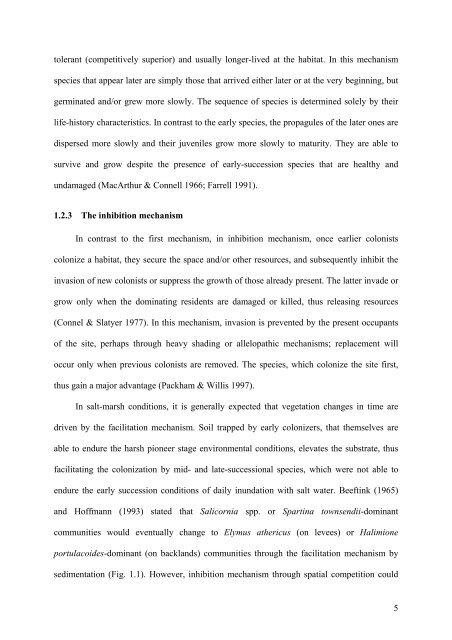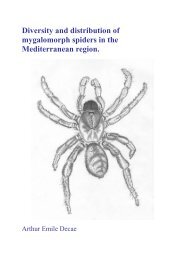- Page 1: Ghent University Faculty of Science
- Page 5: Spatio-temporal aspects of early ve
- Page 9 and 10: Acknowledgements The accomplishment
- Page 11: List of Abbreviations ADF Acid Dete
- Page 14 and 15: XII 3.5 DISCUSSION ................
- Page 16 and 17: 1.1 What is succession? 2 Successio
- Page 20 and 21: also occur in salt-marsh habitat, a
- Page 22 and 23: seed production (Willson 1983; Pric
- Page 24 and 25: 1.3.2 Inundation, vegetation and su
- Page 26 and 27: affected plant species richness in
- Page 28 and 29: 14 In chapter 4, the effects of she
- Page 30 and 31: elationship between soil characteri
- Page 32 and 33: areas which are re-colonized. They
- Page 34 and 35: Fig. 1.4. The position of the newly
- Page 36 and 37: 22 There are some photos available
- Page 38 and 39: were collected systematically along
- Page 40 and 41: Table 1.1. Materials and methods us
- Page 42 and 43: with one or more reference sites (T
- Page 44 and 45: pilot study performed in the area i
- Page 46 and 47: Fig. 1.7. The conceptual framework
- Page 48 and 49: 2.1 Abstract Restoration of salt-ma
- Page 50 and 51: 2.2 Introduction The successful res
- Page 52 and 53: physiological process depending on
- Page 54 and 55: separated from it by a dike (with a
- Page 56 and 57: scale (Londo 1976). According to th
- Page 58 and 59: 2.4.2 Seed bank at the restoration
- Page 60 and 61: Table 2.3. Average (± SE) species
- Page 62 and 63: particular those species coming fro
- Page 64 and 65: germinate, the seeds should have ap
- Page 66 and 67: the restoration site along a strong
- Page 68 and 69:
3.1 Abstract 54 The effect of inund
- Page 70 and 71:
3.2 Introduction 56 Tidal marshes a
- Page 72 and 73:
more stable. Consequently, species
- Page 74 and 75:
3.3.2.2 Inundation frequency 60 The
- Page 76 and 77:
and 2007) for those variables that
- Page 78 and 79:
maritima) increased over time (Fig.
- Page 80 and 81:
perennial species between years, wi
- Page 82 and 83:
68 Perennial richness 1.4 1.2 1 0.8
- Page 84 and 85:
70 Species turnover 1.2 1 0.8 0.6 0
- Page 86 and 87:
Reznicek 1986). They therefore play
- Page 88 and 89:
Suaeda maritima. Spartina is well k
- Page 90 and 91:
4.1 Abstract 76 In this paper, the
- Page 92 and 93:
4.2 Introduction 78 Salt-marshes ar
- Page 94 and 95:
available on the influence of sheep
- Page 96 and 97:
consecutive months, sampling effort
- Page 98 and 99:
factor was applied. In case of sign
- Page 100 and 101:
Table 4.1. The result of repeated m
- Page 102 and 103:
88 Cover(%) 2.5 2 1.5 1 0.5 0 C a b
- Page 104 and 105:
90 2.5 2 1.5 1 0.5 0 a b a b Grazed
- Page 106 and 107:
succession leading to rapid vegetat
- Page 108 and 109:
(van Wijnen et al. 1997). In additi
- Page 110 and 111:
5.1 Abstract 96 It is generally acc
- Page 112 and 113:
5.2 Introduction 98 One of the main
- Page 114 and 115:
area started in 2002, when part of
- Page 116 and 117:
high and highly significant (see Ta
- Page 118 and 119:
104 Although the percentage of spec
- Page 120 and 121:
5.5 Discussion 106 Not surprisingly
- Page 122 and 123:
europaea zone as long as the elevat
- Page 124 and 125:
110
- Page 126 and 127:
6.1 Abstract 112 Seed bank density
- Page 128 and 129:
6.2 Introduction 114 The persistenc
- Page 130 and 131:
116 Our study area consists of thre
- Page 132 and 133:
were also placed randomly on the sh
- Page 134 and 135:
Seed density(m²) Seed density(m²)
- Page 136 and 137:
122 Plant species in the above-grou
- Page 138 and 139:
6.4.2 Seed bank properties and sali
- Page 140 and 141:
Seed density(m²) Seed density(m²)
- Page 142 and 143:
conclude that Suaeda seeds are most
- Page 144 and 145:
130 Both the similarity between sta
- Page 146 and 147:
marsh were found not to be fundamen
- Page 148 and 149:
134 Permanent plots in this study g
- Page 150 and 151:
(soil and elevation), and between v
- Page 152 and 153:
138 In literature it is generally a
- Page 154 and 155:
ecome extinct, some palatable and s
- Page 156 and 157:
production, but their massive produ
- Page 158 and 159:
144 Grazing in the entire year migh
- Page 160 and 161:
146
- Page 162 and 163:
Bakker, E.S. & Olff, H. 2003. The i
- Page 164 and 165:
Bertness, M.D., Wise C. & Ellison A
- Page 166 and 167:
Burrows, C.J. 1990. Processes of ve
- Page 168 and 169:
de Leeuw, J. 1992. Dynamics of salt
- Page 170 and 171:
Egler, F.E. 1954. Vegetation scienc
- Page 172 and 173:
Garbutt, A. & Wolters, M. 2008. The
- Page 174 and 175:
Harper, J.L. 1961. Approaches to th
- Page 176 and 177:
Hoffmann, M. 2006a. 5. De natuurher
- Page 178 and 179:
Janssen, J.A.M. & Schaminée, J.H.J
- Page 180 and 181:
Klotzli, F. & Grootjans, A.P. 2001.
- Page 182 and 183:
Levine, J.M., Brewer, J.S. & Bertne
- Page 184 and 185:
Myster, R.W. & Pickett, S.T.A. 1990
- Page 186 and 187:
Packham, J.R. & Willis, A.J. 1997.
- Page 188 and 189:
Poschlod, P., Tackenberg, O. & Bonn
- Page 190 and 191:
Rozema, J. & Blom B. 1977. Effects
- Page 192 and 193:
Smith, T.B., Kark, S., Schneider, C
- Page 194 and 195:
Thompson, K., Bakker, J.P. & Bekker
- Page 196 and 197:
van Leeuwen, C.G. 1966. A relation
- Page 198 and 199:
Wijnen, H.J.V. & Bakker, J.P. 1999.
- Page 200 and 201:
186
- Page 202 and 203:
of a continuous water bridge betwee
- Page 204 and 205:
190
- Page 206 and 207:
192
- Page 208 and 209:
194
- Page 210 and 211:
196
- Page 212 and 213:
198
- Page 214 and 215:
200
- Page 216 and 217:
202
- Page 218 and 219:
Appendix F - Continued Samolus vala
- Page 220:
Appendix G - Continued Rubus caesio










